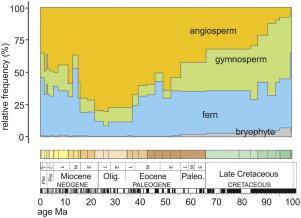Palaeogeography, Palaeoclimatology, Palaeoecology ( IF 3 ) Pub Date : 2021-01-01 , DOI: 10.1016/j.palaeo.2020.110207 Joseph G. Prebble , Elizabeth M. Kennedy , Tammo Reichgelt , Christopher Clowes , Tom Womack , Dallas C. Mildenhall , J. Ian Raine , Erica M. Crouch

|
Although significant angiosperm diversification occurred during the Cretaceous, the timing of subsequent expansion of flowering plants across austral landscapes is poorly understood due to a lack of continuous records. Our new 100 million year composite pollen record from New Zealand shows a striking temporal separation between diversification and ecological dominance in this group. While Cretaceous diversification was closely followed by an increase in angiosperm frequency, maximum frequency did not occur for another 40 million years, during the Eocene. The two most consistent intervals of floral change over the 100 Myr record occur within the middle Eocene and the middle Miocene. Notable floral changes also occur around the Cretaceous-Paleogene, Paleocene-Eocene, and Pliocene-Pleistocene transitions. These major changes occur in the context of the northward drift of Zealandia across the Antarctic circle, global warming in the early Paleogene, and middle Miocene, and onset of Southern Ocean circumpolar circulation and cooling in the late Paleogene.
中文翻译:

来自新西兰的1亿年复合花粉记录显示最大的被子植物丰度推迟到始新世
尽管在白垩纪期间发生了显着的被子植物多样化,但由于缺乏连续记录,人们对开花植物随后扩展到南方景观的时间知之甚少。我们来自新西兰的新的1亿年复合花粉记录显示,这一群体的多样化和生态优势之间存在明显的时间分隔。尽管白垩纪多样化之后是被子植物频率的增加,但在始新世期间,最高频率并没有再出现4000万年。在100 Myr记录上,花变化的两个最一致的间隔发生在中始新世和中新世中。在白垩纪-古近纪,新世-始新世和上新世-更新世过渡附近也发生了明显的花卉变化。



























 京公网安备 11010802027423号
京公网安备 11010802027423号